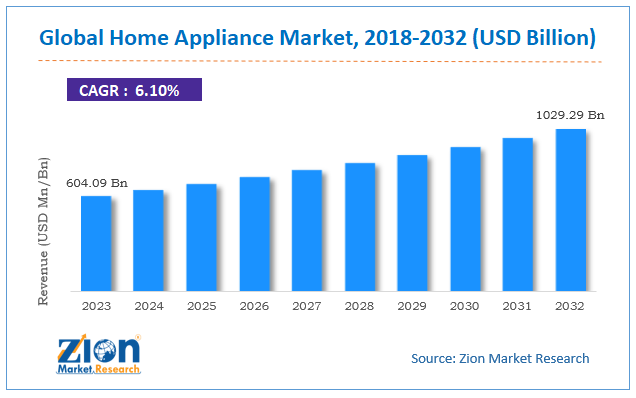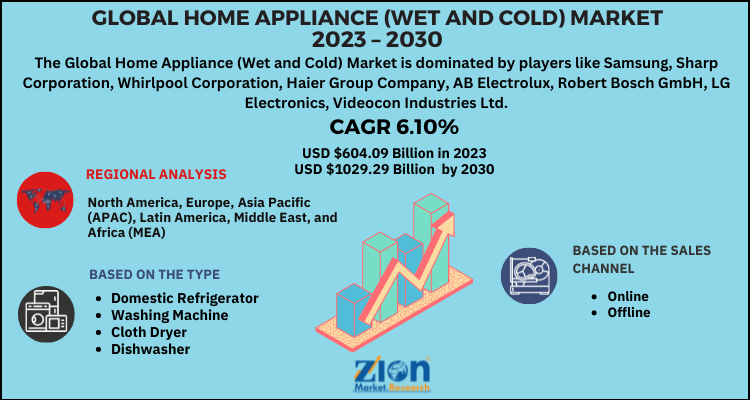Home Appliance (Wet and Cold) Market Growth, Size, Share, Trends, and Forecast 2032

Home Appliance (Wet and Cold) Market By Type (the domestic refrigerator, washing machine, cloth dryer, and dishwasher), By Sales channel (online and offline) And By Region: - Global And Regional Industry Overview, Market Intelligence, Comprehensive Analysis, Historical Data, And Forecasts, 2024-2032
| Market Size in 2023 | Market Forecast in 2032 | Growth Rate (in %) | Base Year |
|---|---|---|---|
| USD 604.09 Billion | USD 1029.29 Billion | CAGR at 6.10% | 2023 |
Description
Global Home Appliance (Wet and Cold) Market: Insights
According to the report published by Zion Market Research, the global Home Appliance (Wet and Cold) Market size was valued at USD 604.09 Billion in 2023 and is predicted to reach USD 1029.29 Billion by the end of 2032. The market is expected to grow with a CAGR of 6.10% during the forecast period. The report analyzes the global Home Appliance (Wet and Cold) Market’s growth drivers, restraints, and impact on demand during the forecast period. It will also help navigate and explore the arising opportunities in the Home Appliance (Wet and Cold) Market industry.
Global Home Appliance (Wet and Cold) Market: Overview
Home appliances specifically wet and cold carry out major household tasks such as the washing clothes & dishes and storing fruits & vegetables in a hygienic manner. Washing machines, dishwashers, and refrigerators are the wet and cold appliances used in houses.
Global Home Appliance (Wet and Cold) Market: Growth Factors
The global home appliance (wet and cold) market is growing at a lucrative rate. Factors such as an increase in disposable income, the busy lifestyle of the people, and an increase in spending on household appliances for convenience are majorly boosting the growth of the global home appliance (wet and cold) market. There is a rise in concerns about gas emissions. Thus, most of the population is preferring towards eco-friendly appliances. These offer numerous benefits which include personal energy savings, water-saving, reduces carbon footprint, and offers better results.
In addition to this, the manufacturers have developed smart appliances and are majorly focusing on continuous up-gradation of the appliances making the life of the consumer much easier. All these factors and the rise in purchasing power, huge investments of the key market players in R&D activities, and rapid urbanization in developing countries are equally contributing to the growth of the market. Moreover, an increase in the number of tech-savvy consumers, a wide range of options in wet & cold appliances, and easy availability of these appliances on e-commerce platforms with numerous discounts are also some of the major features that are boosting the growth of the market.
Furthermore, the rise in the integration of artificial intelligence-based technology with home appliances may lead to plenty of opportunities for the growth of the global home appliance (wet and cold) market over the forecast period. However, the high price related to the appliances may hinder the growth of the global home appliance (wet and cold) market in developing and underdeveloped countries.
Key Insights
- As per the analysis shared by our research analyst, the global Home Appliance (Wet and Cold) Market is estimated to grow annually at a CAGR of around 6.10% over the forecast period (2024-2032).
- In terms of revenue, the global Home Appliance (Wet and Cold) Market size was valued at around USD 604.09 Billion in 2023 and is projected to reach USD 1029.29 Billion by 2032.
- Based on the type, the domestic refrigerators this segment holds the largest market share, accounting for approximately 40% of the total market. The dominance is driven by continuous innovations such as energy-efficient models and smart technology integration, catering to evolving consumer preferences for multifunctional and connected appliances.
- Based on the sales channel, the offline channels traditional retail outlets, including supermarkets, hypermarkets, and specialty stores, remain the dominant sales channels, capturing around 60% of the market share. Consumers often prefer in-store experiences for major appliance purchases, valuing the ability to physically inspect products and receive immediate assistance.
- Based on the region, the Asia Pacific this region leads the global Home Appliance (Wet and Cold) market, driven by rapid urbanization, a growing middle-class population, and increased adoption of modern lifestyles in countries like China and India. Factors such as rising disposable incomes and expanding retail networks further contribute to the region's market dominance.
Home Appliance (Wet and Cold) Market: Dynamics
Key Growth Drivers
The home appliance (wet and cold) market, which includes products like washing machines, refrigerators, and freezers, is driven by increasing urbanization and rising disposable incomes. Consumers are seeking convenience and time-saving solutions, fueling the demand for technologically advanced and energy-efficient appliances. Additionally, the growing emphasis on smart home technology, with appliances offering connectivity and remote control via smartphones, further supports market growth. Government initiatives promoting energy efficiency and the replacement of old appliances with eco-friendly models also contribute to the expansion of the market. Furthermore, the rising demand from emerging economies with expanding middle-class populations presents substantial growth opportunities.
Restraints
The market faces restraints primarily due to the high initial cost of advanced appliances, which may limit their adoption in price-sensitive regions. Energy consumption concerns, despite the availability of energy-efficient models, remain a challenge for some consumers. Additionally, the long product lifecycle of durable home appliances means slower replacement rates, hindering continuous sales growth. Supply chain disruptions, fluctuating raw material prices, and increased tariffs on electronic goods also pose significant challenges for manufacturers. Furthermore, limited awareness of smart appliance benefits in certain regions can restrict market penetration.
Opportunities
Technological advancements in the home appliance sector present numerous opportunities for market expansion. Innovations such as IoT-enabled appliances, voice control integration, and AI-powered functionalities offer enhanced user experiences and drive consumer interest. Sustainability trends are encouraging the development of eco-friendly and energy-efficient appliances, which aligns with regulatory standards and consumer preferences. The growing adoption of e-commerce platforms and digital marketing strategies further opens up new sales channels for manufacturers. Additionally, after-sales services and appliance leasing models provide opportunities for companies to build customer loyalty and generate recurring revenue.
Challenges
The home appliance (wet and cold) market faces challenges related to intense competition and price wars among established brands and emerging players. Companies must continuously innovate to differentiate their products in a saturated market. Additionally, ensuring compliance with varying regulations and environmental standards across different regions can be complex and resource-intensive. Consumer concerns over data privacy and cybersecurity with smart appliances also pose a barrier to adoption. Moreover, the rapid technological evolution may lead to product obsolescence, requiring companies to invest heavily in research and development to stay competitive. Environmental concerns over appliance disposal and recycling further add to the industry's challenges.
Home Appliance (Wet and Cold) Market: Report Scope
| Report Attributes | Report Details |
|---|---|
| Report Name | Home Appliance (Wet and Cold) Market Research Report |
| Market Size in 2023 | USD 604.09 Billion |
| Market Forecast in 2032 | USD 1029.29 Billion |
| Growth Rate | CAGR of 6.10% |
| Number of Pages | 196 |
| Key Companies Covered | Samsung, Sharp Corporation, Whirlpool Corporation, Haier Group Company, AB Electrolux, Robert Bosch GmbH, LG Electronics, Videocon Industries Ltd., Panasonic Corporation, Philips Electronics, and Sub-Zero Wolf |
| Segments Covered | By Type, By Sales channel and By Region |
| Regions Covered | North America, Europe, Asia Pacific (APAC), Latin America, Middle East, and Africa (MEA) |
| Base Year | 2023 |
| Historical Year | 2018 to 2022 |
| Forecast Year | 2024 - 2032 |
| Customization Scope | Avail customized purchase options to meet your exact research needs. Request For Customization |
Global Home Appliance (Wet and Cold) Market: Segmentation
The global home appliance (wet and cold) market is segregated based on type, sales channel, and region. All the segments have been analyzed based on present and future trends and the market is estimated from 2024 to 2032.
Based on the type, the global home appliance (wet and cold) market is divided into the domestic refrigerator, washing machine, cloth dryer, and dishwasher. Among these, the domestic refrigerator is estimated to dominate the market. The washing machine segment is also expected to contribute a significant share to the market growth.
Based on the sales channel, the global market is split into online and offline. Among these, the online segment is expected to lead the market due to the trend of digitalization and heavy discounts & coupons offered by the e-commerce platforms.
The regional segment includes the current and forecast demand for North America, Europe, Asia Pacific, Latin America, and the Middle East and Africa.
Global Home Appliance (Wet and Cold) Market: Regional Analysis
The Asia-Pacific region dominates the global home appliance (wet and cold) market, driven by high demand in countries like China, India, and Japan. According to recent industry reports, APAC holds over 40% market share, attributed to rapid urbanization, rising disposable incomes, and increasing adoption of smart appliances. China leads as the largest producer and consumer, supported by strong manufacturing capabilities and government incentives. India is the fastest-growing market due to expanding middle-class demand for refrigerators and washing machines.
North America and Europe follow, with steady growth driven by replacement demand and energy-efficient appliances. However, APAC's dominance is expected to strengthen further, with projections indicating a CAGR of 6-8% through 2030, outpacing other regions.
Global Home Appliance (Wet and Cold) Market: Competitive Players
- Samsung
- Sharp Corporation
- Whirlpool Corporation
- Haier Group Company
- AB Electrolux
- Robert Bosch GmbH
- LG Electronics
- Videocon Industries Ltd.
- Panasonic Corporation
- Philips Electronics
- Sub-Zero Wolf
Are some of the key participants operating in the global home appliance (wet and cold) market.
Global Home Appliance (Wet and Cold) Market: Segment Analysis
Based on the Type
- Domestic refrigerator
- Washing machine
- Cloth dryer
- Dishwasher
Based on the Sales Channel
- Online
- Offline
Global Home Appliance (Wet and Cold) Market: Regional Segment Analysis
- North America
- The U.S.
- Canada
- Europe
- France
- The UK
- Spain
- Germany
- Italy
- Rest of Europe
- Asia Pacific
- China
- Japan
- India
- South Korea
- Southeast Asia
- Rest of Asia Pacific
- Latin America
- Brazil
- Mexico
- Rest of Latin America
- Middle East & Africa
- GCC
- South Africa
- Rest of Middle East & Africa
What Reports Provides
- Full in-depth analysis of the parent market
- Important changes in market dynamics
- Segmentation details of the market
- Former, on-going, and projected market analysis in terms of volume and value
- Assessment of niche industry developments
- Market share analysis
- Key strategies of major players
- Emerging segments and regional markets
- Testimonials to companies in order to fortify their foothold in the market.
Table Of Content
FrequentlyAsked Questions
The global home appliance (wet and cold) market is growing at a lucrative rate. Factors such as an increase in disposable income, the busy lifestyle of the people, and an increase in spending on household appliances for convenience are majorly boosting the growth of the global home appliance (wet and cold) market. Furthermore, the rise in the integration of artificial intelligence-based technology with home appliances may lead to plenty of opportunities for the growth of the global home appliance (wet and cold) market over the forecast period.
Samsung, Sharp Corporation, Whirlpool Corporation, Haier Group Company, AB Electrolux, Robert Bosch GmbH, LG Electronics, Videocon Industries Ltd., Panasonic Corporation, Philips Electronics, and Sub-Zero Wolf are some of the key participants operating in the global home appliance (wet and cold) market.
Regionally, in terms of revenue, Asia Pacific is estimated to hold the largest share in the global home appliance (wet and cold) market. Factors such as rise in the standard of living, growing economies, increase in spending, and rapid urbanization is the key factors that are spurring the growth of the market in this region.
HappyClients
Zion Market Research
Tel: +1 (302) 444-0166
USA/Canada Toll Free No.+1 (855) 465-4651
3rd Floor,
Mrunal Paradise, Opp Maharaja Hotel,
Pimple Gurav, Pune 411061,
Maharashtra, India
Phone No +91 7768 006 007, +91 7768 006 008
US OFFICE NO +1 (302) 444-0166
US/CAN TOLL FREE +1 (855) 465-4651
Email: sales@zionmarketresearch.com
We have secured system to process your transaction.
Our support available to help you 24 hours a day, five days a week.
Monday - Friday: 9AM - 6PM
Saturday - Sunday: Closed








